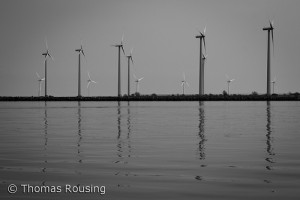by Teresa Parejo Navajas
Associate Professor of Law (Carlos III University, Spain)
Visiting Scholar at the Center for Climate Change Law
The EU Strategy 2020, adopted in 2010, is about delivering growth for a smart, sustainable and inclusive economy with more effective investments in education, research and innovation; a decisive move towards a low-carbon economy; and a strong emphasis on job creation and poverty reduction. Therefore, it is not only about redefining the climate change policy, but also, reinforcing the competitiveness of the EU in the context of the economic and financial crisis.
EU targets for sustainable growth include: i) reducing GHG emissions by 20% compared to 1990 levels by 2020, with a desire to elevate the target to 30% if other developed countries make similar commitments and developing countries contribute according to their abilities, as part of a comprehensive global agreement; ii) increasing the share of renewables in final energy consumption to 20%; and iii) moving towards a 20% increase in energy efficiency. This 20-20-20 objective is achievable, most likely due to the financial crisis, which has reduced significantly the use of energy in all Member States. Be that as it may, the European Environment Agency has proudly shown the reduction of the GHG emissions in November 2013 in 18%, very close to the 2020 objective, but 8 years early.
But the European Commissioner for Climate Action, Ms. Connie Hedegaard, has gone further, proposing an even more ambitious plan for the next decade: a binding, legislatively mandated target of a 40% GHG reduction for the year 2030 and a 30% share of renewables in energy consumption. Her ambition is not shared by everyone in the EU. The proposal is supported by The Green Growth Group, an informal grouping of like-minded energy, climate and environment Ministers from 13 EU Member States (UK, Germany, France, Italy, Spain, Netherlands, Belgium, Portugal, Sweden, Denmark, Finland, Slovenia and Estonia), but has not yet persuaded the Ministries of Industry and Energy, who emphasize competitiveness over sustainability.
According to the Green Growth Group, “(…) The European Union faces many challenges, but the challenge of how to build a competitive economy while tackling climate change is one of the most pressing. Some would argue that you can’t do both at the same time – that one must take priority over the other. We firmly disagree. Economic growth and sustainability are not mutually exclusive. We believe that Europe must see cutting harmful emissions and cost-efficiently and cost-effectively decarbonising our economy as part of the solution to our economic and wider challenges, as well as a moral imperative.”
Hedegaard’s proposal does not go far enough for some environmental organizations, including WWF and Greenpeace, who believe that the 40% objective is too modest, and recall that the Commission itself has considered a 45% reduction scenario. They agree, however, that the EU should include a target to increase the share of renewables—a proposition also supported by Ministers from Germany, France, and six other countries. These ministers formally called, in December 2013, for the EU to set a 2030 goal for renewable energy use “to assure the energy investments and to reduce the import dependency”, in opposition to their British counterpart, who advocates solely a GHG target.
But that is not all. The Coalition for Energy Savings, the European Renewable Energy Council and the Climate Action Network Europe, representing key energy savings, renewable energy and climate change mitigation stakeholders in Europe, elaborated, in November 2013, a report regarding the impact assessment for the 2030 climate and energy framework of the EU in which they call for a coherent and credible EU 2030 policy framework that will respond to the threat of climate change, reduce energy costs and import dependence, help the EU to compete at the international level and achieve a job-rich economic recovery. Among other things, the Coalition urges the Commission to include the full range of plausible scenarios for: i) reductions of greenhouse gas emissions by 2030 including reductions of 50% and 55% compared to 1990 levels; ii) final energy savings of 40% (compared to 2009 reference projections) and a renewable energy share of 45%, including the available policy options of setting targets and policies to realize the cost-effective potentials, without arbitrarily restricting them by climate policies; and iii) reductions of non-energy related greenhouse gas emissions, which would come in addition to the reduction delivered by energy efficiency and renewable policies.
Furthermore, the staff working document from the European Commission concerning the impact assessment for the 2030 climate and energy policy framework points out that with a 40% GHG emissions reduction, fossil fuel imports will only decrease 7%; but if the reduction rises to 45% and is coupled with a 35% renewables obligation, the imports payment for fossil fuels will be reduced by 19%.
Linked to this, the European Commission is also preparing a mechanism to tackle the problems caused by an excess of emission allowances in the European carbon market, which has caused a drastic price drop. Indeed, as a short-term measure, the Commission has postponed the auctioning of 900 million allowances (backloading) from 2013-2015 to later in phase three (which goes from 2013 to 2020) of the EU emissions trading system, in order to stabilize current prices. The Commission’s backloading decision is an important stop-gap measure to maintain confidence and predictability in the market, but longer-term structural reform of the market will be critical if the ETS is to remain a key element of EU climate policy.
As these controversies illustrate, the EU is at an important decision-making juncture over the future ambition of its climate policy, and is facing these decisions amidst many economic woes. But those pushing for ambitious targets are right to highlight that competitiveness and sustainability need not be at odds. To the contrary, given the projected economic and social effects of climate change, it seems increasingly likely that the successful economies of the future will be low carbon. In short, the time has come to move from theory to practice, to kick-start the EU Strategy 2020 and to create a more competitive EU by adopting public policies aimed at the promotion of investment in low-carbon economy projects.
Photo courtesy of Thomas Rousing




